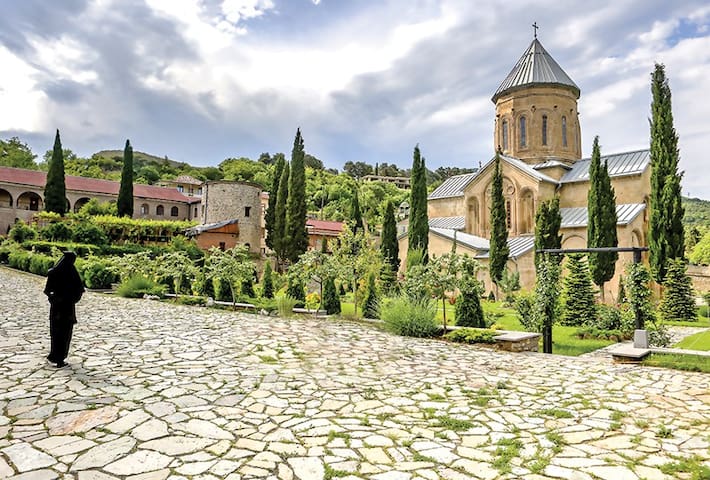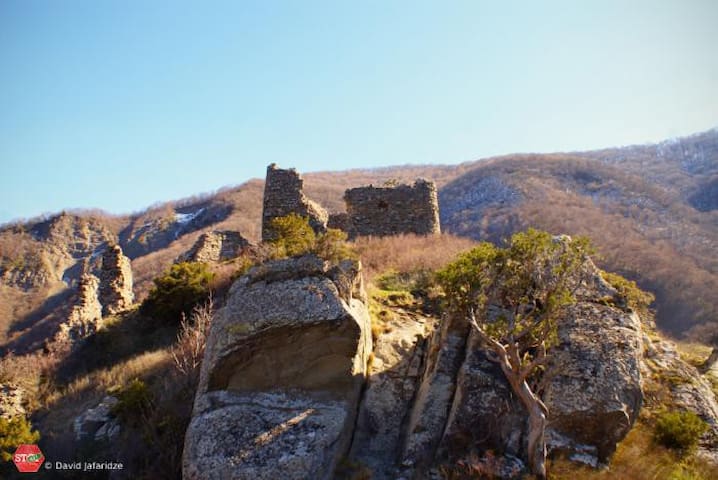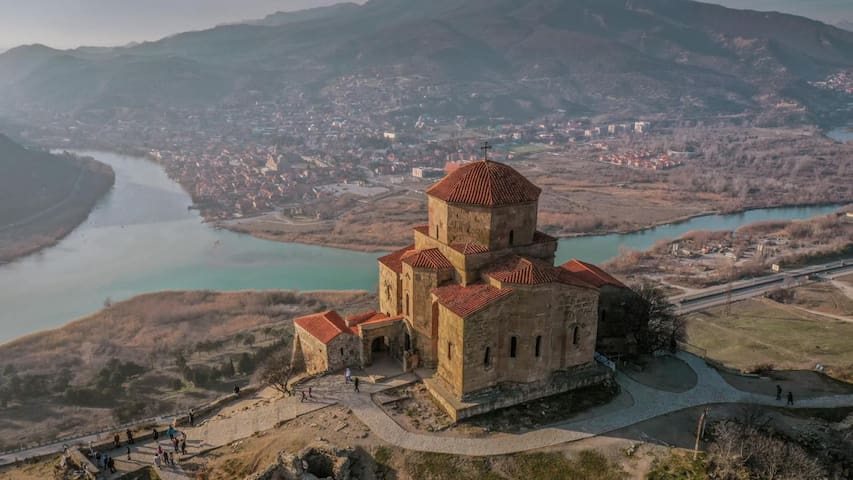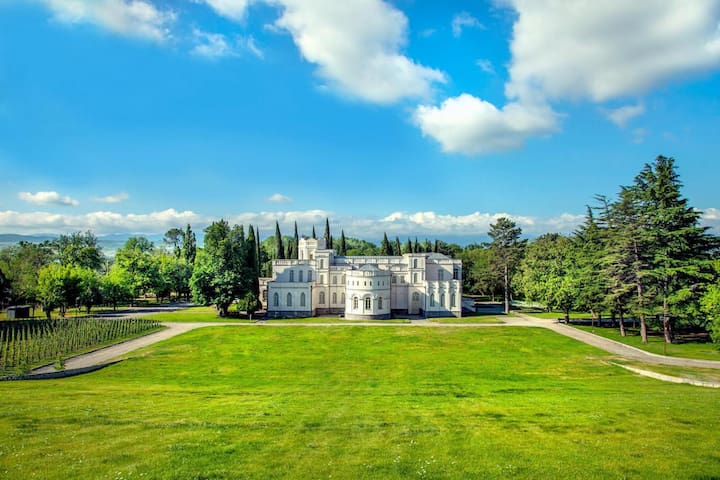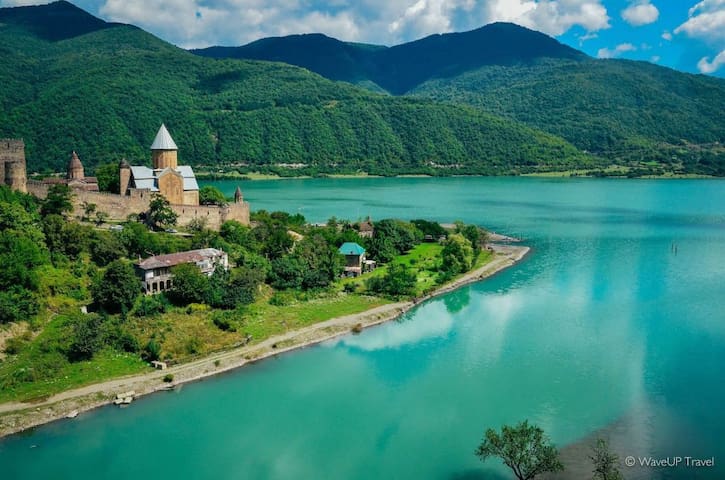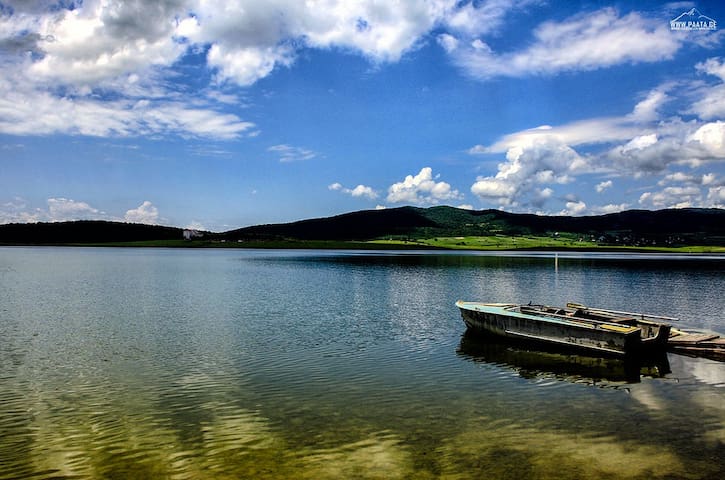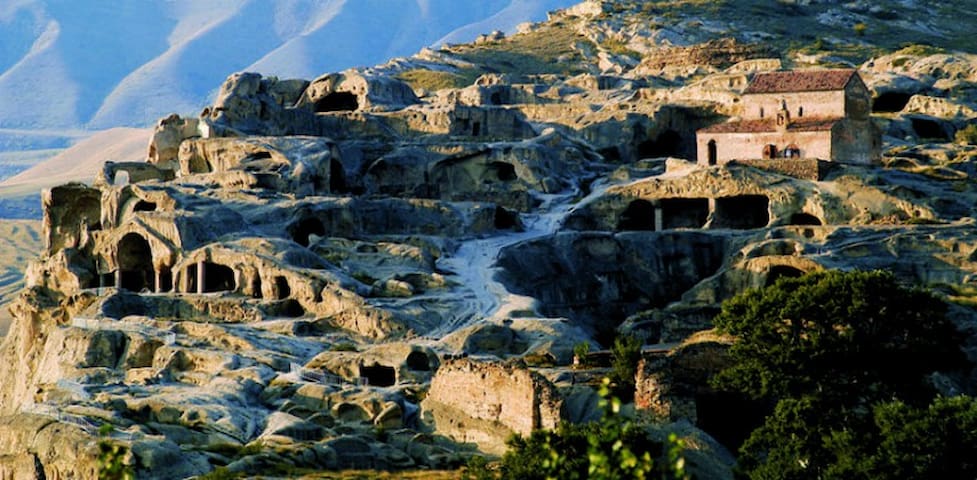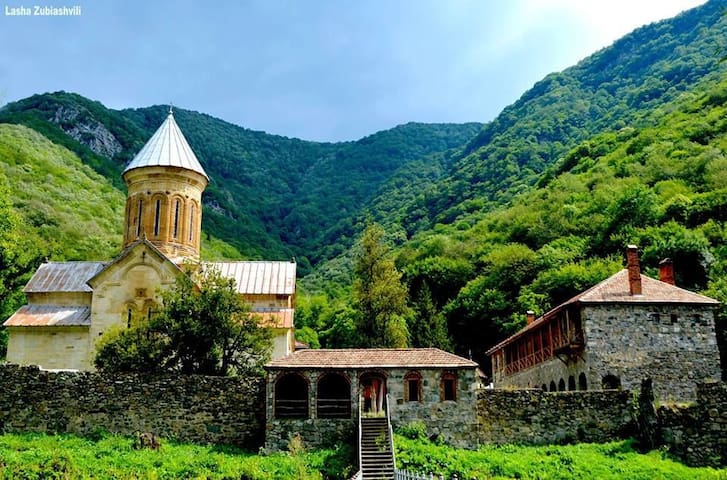Sightseeing
Mtskheta is a tiny, calm and nice city. You can walk by feet even in every corner of the city.
The top places to visit are:
1.Svetitskhoveli
2.Jvari (amazing sightseeing from mountains)
3.Samtavro Kathedral
4.Shio-Mghvime (little city in stones and ortodox religious monks life traditions)
5.Zedazeni (saguramo) - near Mtskheta, nice place on mountains and sightseeings. If you love bikes, you can join bike-tours.
6.Armazi castle- new mtskheta is one historical place, named "Armazi" and surrounding by amazing nuture.
Mtskheta is one of the oldest city in Georgia. it's full of sightseeings and historical places.
214 Recomendado por los habitantes de la zona
Mtskheta
Mtskheta is one of the oldest city in Georgia. it's full of sightseeings and historical places.
Samtavro Monastery
Samtavro Monastery Orthodox Church and Nunnery of St. Nino in Mtskheta, Georgia, were built in the 4th century by King Mirian III of Iberia. The church was reconstructed in the 11th century by King George I and Catholicos-Patriarch Melkisedek. The famous Georgian Saint monk Gabriel is buried in the yard of Samtavro Church.
(600 meter distance from BANINAI HOUSE)
Samtavro Cemetery
Narekvavi-Mtskheta-Railway StationSamtavro Monastery
Samtavro Monastery Orthodox Church and Nunnery of St. Nino in Mtskheta, Georgia, were built in the 4th century by King Mirian III of Iberia. The church was reconstructed in the 11th century by King George I and Catholicos-Patriarch Melkisedek. The famous Georgian Saint monk Gabriel is buried in the yard of Samtavro Church.
(600 meter distance from BANINAI HOUSE)
Armazi
is a locale in Georgia, 4 km southwest of Mtskheta and 22 km northwest of Tbilisi. A part of historical Greater Mtskheta, it is a place where the ancient city of the same name and the original capital of the early Georgian kingdom of Kartli or Iberia was located. It particularly flourished in the early centuries CE and was destroyed by the Arab invasion in the 730s.
(4.8 kilometers distance from BANIANI HOUSE)
Armazi -Bagineti
Minor excavations on the territory of Armazi carried out in 1890 revealed the plinth of adobe town walls, with stone steps, and cleared the two-room structure, where fragments of a woman's torso of the 1st century AD were discovered. From 1943 to 1948 large-scale excavation was undertaken under Andria Apakidze of the Georgian Academy of Sciences, resumed in 1985 and continuing. These have shown that the adobe town walls and towers, built upon a plinth of hewn stone in the first half of the 1st century AD, surrounded the hill top and the side sloping down towards the river, an area of 30 ha. The land within the walls was terraced and various buildings were sited on the terraces.
The three major cultural layers have been identified: the earliest dates back to the 4th-3rd century BC (Armazi I), the middle one is from the 3rd-1st century BC (Armazi II), and the relatively newer structure belongs to the 1st-6th century AD (Armazi III). Armazi I is constructed of massive stone blocks forming an impregnable base but were finished off by less durable mud brick. It also contains a great hall of six columns with a tiled roof. Armazi II is noted for a temple with an apse. Armazi III is the richest layer constructed of elegantly cut stone blocks, joined together with lime mortar and metal clamps. Among the surviving structures are the royal palace, several richly decorated tombs, a bathhouse and a small stone mausoleum.
The area is now a state-protected field museum administered as a part of the National Archaeology Museum-Reserve of Greater Mtskheta.
(3.5 kilometers distance from BANIANI HOUSE)
Armazis Kheoba
Armazi
is a locale in Georgia, 4 km southwest of Mtskheta and 22 km northwest of Tbilisi. A part of historical Greater Mtskheta, it is a place where the ancient city of the same name and the original capital of the early Georgian kingdom of Kartli or Iberia was located. It particularly flourished in the early centuries CE and was destroyed by the Arab invasion in the 730s.
(4.8 kilometers distance from BANIANI HOUSE)
Armazi -Bagineti
Minor excavations on the territory of Armazi carried out in 1890 revealed the plinth of adobe town walls, with stone steps, and cleared the two-room structure, where fragments of a woman's torso of the 1st century AD were discovered. From 1943 to 1948 large-scale excavation was undertaken under Andria Apakidze of the Georgian Academy of Sciences, resumed in 1985 and continuing. These have shown that the adobe town walls and towers, built upon a plinth of hewn stone in the first half of the 1st century AD, surrounded the hill top and the side sloping down towards the river, an area of 30 ha. The land within the walls was terraced and various buildings were sited on the terraces.
The three major cultural layers have been identified: the earliest dates back to the 4th-3rd century BC (Armazi I), the middle one is from the 3rd-1st century BC (Armazi II), and the relatively newer structure belongs to the 1st-6th century AD (Armazi III). Armazi I is constructed of massive stone blocks forming an impregnable base but were finished off by less durable mud brick. It also contains a great hall of six columns with a tiled roof. Armazi II is noted for a temple with an apse. Armazi III is the richest layer constructed of elegantly cut stone blocks, joined together with lime mortar and metal clamps. Among the surviving structures are the royal palace, several richly decorated tombs, a bathhouse and a small stone mausoleum.
The area is now a state-protected field museum administered as a part of the National Archaeology Museum-Reserve of Greater Mtskheta.
(3.5 kilometers distance from BANIANI HOUSE)
Zedazeni Monastery
is a Georgian Orthodox monastery, located on the Zedazeni mountain the hills of Saguramo, northeast to Mtskheta and to the east side of the Aragvi River.
The monastery was founded by Saint John, one of the Holy Assyrian Fathers of Georgia whose mission was to strengthen Christianity in the region.
(14.5 kilometers distance from BANIANI HOUSE)
11 Recomendado por los habitantes de la zona
Zedazeni Monastery
Zedazeni Road
Zedazeni Monastery
is a Georgian Orthodox monastery, located on the Zedazeni mountain the hills of Saguramo, northeast to Mtskheta and to the east side of the Aragvi River.
The monastery was founded by Saint John, one of the Holy Assyrian Fathers of Georgia whose mission was to strengthen Christianity in the region.
(14.5 kilometers distance from BANIANI HOUSE)
Jvari Monastery
The name of this monastery translated as the "Monastery of the Cross". For the Georgian monastery in Jerusalem with the same name, see Monastery of the Cross.
Jvari Monastery is a sixth-century Georgian Orthodox monastery near Mtskheta, eastern Georgia. Along with other historic structures of Mtskheta, it is listed as a World Heritage site by UNESCO
Jvari Monastery stands on the rocky mountaintop at the confluence of the Mtkvari and Aragvi rivers, overlooking the town of Mtskheta, which was formerly the capital of the Kingdom of Iberia.
(17 kilometers distance from BANIANI HOUSE)
52 Recomendado por los habitantes de la zona
Monasterio de Jvari de Mtskheta
Jvari Monastery
The name of this monastery translated as the "Monastery of the Cross". For the Georgian monastery in Jerusalem with the same name, see Monastery of the Cross.
Jvari Monastery is a sixth-century Georgian Orthodox monastery near Mtskheta, eastern Georgia. Along with other historic structures of Mtskheta, it is listed as a World Heritage site by UNESCO
Jvari Monastery stands on the rocky mountaintop at the confluence of the Mtkvari and Aragvi rivers, overlooking the town of Mtskheta, which was formerly the capital of the Kingdom of Iberia.
(17 kilometers distance from BANIANI HOUSE)
Ilia Chavchavadze Saguramo state museum
The museum complex includes the residence, auxiliary buildings, and the family vineyards of the famous Georgian writer and public figure Ilia Chavchavadze (1837-1907). The museum preserves memorial items and manuscripts from the writer, photo portraits of famous XIX century Georgian public figures and photographs reflecting the time period.
(12.1 kilometers distance from BANIANI HOUSE)
Saguramo
Ilia Chavchavadze Saguramo state museum
The museum complex includes the residence, auxiliary buildings, and the family vineyards of the famous Georgian writer and public figure Ilia Chavchavadze (1837-1907). The museum preserves memorial items and manuscripts from the writer, photo portraits of famous XIX century Georgian public figures and photographs reflecting the time period.
(12.1 kilometers distance from BANIANI HOUSE)
Chateau Mukhrani
If you are a wine enthusiast, a couple looking for a romantic getaway, or a group in search of outdoor adventure, this is the best place to go!
Chateau Mukhrani is one of the must-visit venues to get a fascinating insight into the traditions and secrets of Georgian wine-making, blended with remarkable stories about the Georgian royal family.
Situated 25 minutes from Tbilisi it is the first Georgian Chateau. Fabulous castle and cellars, wonderful gardens and vineyards made Chateau Mukhrani world-renowned.
You can discover the Georgian royal family history and breath-taking legends, a flavor of antiquity and enchanting wines.
(25 kilometers distance from BANIANI HOUSE)
Mukhrani
Chateau Mukhrani
If you are a wine enthusiast, a couple looking for a romantic getaway, or a group in search of outdoor adventure, this is the best place to go!
Chateau Mukhrani is one of the must-visit venues to get a fascinating insight into the traditions and secrets of Georgian wine-making, blended with remarkable stories about the Georgian royal family.
Situated 25 minutes from Tbilisi it is the first Georgian Chateau. Fabulous castle and cellars, wonderful gardens and vineyards made Chateau Mukhrani world-renowned.
You can discover the Georgian royal family history and breath-taking legends, a flavor of antiquity and enchanting wines.
(25 kilometers distance from BANIANI HOUSE)
Zhinvali water reservoir
Zhinvali, also Jinvali, is an artificial water reservoir located on the river Aragvi in Georgia. The building of the hydroelectric dam formed the Zhinvali Reservoir. The dam has been built in 1986.
(38 kilometers distance from BANIANI HOUSE)
Ananuri
Ananuri was a castle and seat of the Eristavis (Dukes) of Aragvi, a feudal dynasty which ruled the area from the 13th century. The castle was the scene of numerous battles.
In 1739, Ananuri was attacked by forces from a rival duchy, commanded by Shanshe of Ksani and was set on fire. The Aragvi clan was massacred. However, four years later, the local peasants revolted against rule by the Shamshe, killing the usurpers and inviting King Teimuraz II to rule directly over them. However, in 1746, King Teimuraz was forced to suppress another peasant uprising, with the help of King Erekle II of Kakheti. The fortress remained in use until the beginning of the 19th century. In 2007, the complex has been on the tentative list for inclusion into the UNESCO World Heritage Site program.
(46 kilometers distance from BANIANI HOUSE)
Zhinvali Reservoir
Zhinvali water reservoir
Zhinvali, also Jinvali, is an artificial water reservoir located on the river Aragvi in Georgia. The building of the hydroelectric dam formed the Zhinvali Reservoir. The dam has been built in 1986.
(38 kilometers distance from BANIANI HOUSE)
Ananuri
Ananuri was a castle and seat of the Eristavis (Dukes) of Aragvi, a feudal dynasty which ruled the area from the 13th century. The castle was the scene of numerous battles.
In 1739, Ananuri was attacked by forces from a rival duchy, commanded by Shanshe of Ksani and was set on fire. The Aragvi clan was massacred. However, four years later, the local peasants revolted against rule by the Shamshe, killing the usurpers and inviting King Teimuraz II to rule directly over them. However, in 1746, King Teimuraz was forced to suppress another peasant uprising, with the help of King Erekle II of Kakheti. The fortress remained in use until the beginning of the 19th century. In 2007, the complex has been on the tentative list for inclusion into the UNESCO World Heritage Site program.
(46 kilometers distance from BANIANI HOUSE)
Bazaleti Lake
The Bazaleti Lake is a lake in eastern Georgia some 60 km northwest of the nation's capital Tbilisi and 5 km south of the town of Dusheti. It is used for fish culture, irrigation and recreation. The nearby village and the historical district around the lake are also known as Bazaleti.
The surface area of the lake is 1.22 km². and its maximum depth is 30 m. The area around the lake housed a flourishing medieval town and is surrounded by many legends. In 1626, the Battle of Bazaleti between two rival Georgian factions took place there.
Currently, the area is a popular recreational area served by a modern tourist complex.
It is known that Bazaleti lake has an outflow but it has not been discovered. Locals claim that the water recirculates. They tell a story about a bull which was drowned in the lake and was later found in a well in the nearby village.
According to local legend, a golden-haired child is lying in a golden crib on the bottom of the lake. The lake was formed from his mother's tears. The story is retold in a Georgian poem
(32 Kilometers distance from BANIANI HOUSE)
6 Recomendado por los habitantes de la zona
Bazaleti Lake
Bazaleti Lake
The Bazaleti Lake is a lake in eastern Georgia some 60 km northwest of the nation's capital Tbilisi and 5 km south of the town of Dusheti. It is used for fish culture, irrigation and recreation. The nearby village and the historical district around the lake are also known as Bazaleti.
The surface area of the lake is 1.22 km². and its maximum depth is 30 m. The area around the lake housed a flourishing medieval town and is surrounded by many legends. In 1626, the Battle of Bazaleti between two rival Georgian factions took place there.
Currently, the area is a popular recreational area served by a modern tourist complex.
It is known that Bazaleti lake has an outflow but it has not been discovered. Locals claim that the water recirculates. They tell a story about a bull which was drowned in the lake and was later found in a well in the nearby village.
According to local legend, a golden-haired child is lying in a golden crib on the bottom of the lake. The lake was formed from his mother's tears. The story is retold in a Georgian poem
(32 Kilometers distance from BANIANI HOUSE)
Uplistsikhe
Uplistsikhe, literally, "the lord's fortress" is an ancient rock-hewn town in eastern Georgia, some 10 kilometers east of the town of Gori, Shida Kartli.
Built on a high rocky left bank of the Mtkvari River, it contains various structures dating from the Early Iron Age to the Late Middle Ages, and is notable for the unique combination of various styles of rock-cut cultures from Anatoliaand Iran, as well as the co-existence of pagan and Christian architecture.
(61 kilometers distance from BANIANI HOUSE)
38 Recomendado por los habitantes de la zona
Uplistsikhe
Uplistsikhe Complex RoadUplistsikhe
Uplistsikhe, literally, "the lord's fortress" is an ancient rock-hewn town in eastern Georgia, some 10 kilometers east of the town of Gori, Shida Kartli.
Built on a high rocky left bank of the Mtkvari River, it contains various structures dating from the Early Iron Age to the Late Middle Ages, and is notable for the unique combination of various styles of rock-cut cultures from Anatoliaand Iran, as well as the co-existence of pagan and Christian architecture.
(61 kilometers distance from BANIANI HOUSE)
Kvatakhevi
is a medieval Georgian Orthodox monastery in Shida Kartli, Georgia, 55 km (34 mi) west of the nation’s capital of Tbilisi.
The Kvatakhevi monastic complex is situated near the village Kavtiskhevi at the end of the gorge cut by a stream in the northern slopes of the Trialeti Range, protected on three sides by the steep mountain slopes. It dates to the 12th-13th century, and resembles the monasteries of Betania, Pitareti, and Timotesubani in its architectural form and decoration, reflecting a contemporary canon of a Georgian domed church architecture. The overall plan is nearly a square, with the dome resting upon 2 freely standing pillars and 2 pillars fused with the ledges of the altar. The internal space of the church is formed by the arms of the cross and the dome which surmounts the crossing point.
The building has two portals, one to the south and one to the west. The façades are covered with finely hewn white stone squares. The decoration abounds in fretwork, especially around the windows and the base of the dome; the eastern façade is adorned with a large ornate cross.
Historically, Kvatakhevi was also a literary center where several manuscripts were copied. It also possessed a treasure with many artifacts of medieval Georgian jewelry, a sizeable portion of which was later acquired by and are now on display at the Moscow State Historical Museum.
The monastery was significantly damaged during Timur's invasions of Georgia in the 14th century, but was subsequently repaired, more completely under the patronage of Prince Ivane Tarkhan-Mouravi in 1854. A belfry was added in 1872.
(26 Kilometers distance from BANIANI HOUSE)
Kvatakhevi Monastery
Zahesi-Mtskheta-Kavtiskhevi-Gori-Tsinarekhi-KvatakheviKvatakhevi
is a medieval Georgian Orthodox monastery in Shida Kartli, Georgia, 55 km (34 mi) west of the nation’s capital of Tbilisi.
The Kvatakhevi monastic complex is situated near the village Kavtiskhevi at the end of the gorge cut by a stream in the northern slopes of the Trialeti Range, protected on three sides by the steep mountain slopes. It dates to the 12th-13th century, and resembles the monasteries of Betania, Pitareti, and Timotesubani in its architectural form and decoration, reflecting a contemporary canon of a Georgian domed church architecture. The overall plan is nearly a square, with the dome resting upon 2 freely standing pillars and 2 pillars fused with the ledges of the altar. The internal space of the church is formed by the arms of the cross and the dome which surmounts the crossing point.
The building has two portals, one to the south and one to the west. The façades are covered with finely hewn white stone squares. The decoration abounds in fretwork, especially around the windows and the base of the dome; the eastern façade is adorned with a large ornate cross.
Historically, Kvatakhevi was also a literary center where several manuscripts were copied. It also possessed a treasure with many artifacts of medieval Georgian jewelry, a sizeable portion of which was later acquired by and are now on display at the Moscow State Historical Museum.
The monastery was significantly damaged during Timur's invasions of Georgia in the 14th century, but was subsequently repaired, more completely under the patronage of Prince Ivane Tarkhan-Mouravi in 1854. A belfry was added in 1872.
(26 Kilometers distance from BANIANI HOUSE)
The Ateni Sioni Church
is an early 7th-century Georgian Orthodox church in the village of Ateni, some 10 km (6.2 mi) south of the city of Gori, Georgia. It stands in a setting of the Tana River valley known not only for its historical monuments but also for its picturesque landscapes and wine. The name "Sioni" derives from Mount Zion at Jerusalem.
Near Church is Chateau Ateni near Gori, if you love wine and winery experience.
(65 kilometers distance from BANIANI HOUSE)
6 Recomendado por los habitantes de la zona
Ateni Sioni Church
Khidistavi-Ateni-BoshuriThe Ateni Sioni Church
is an early 7th-century Georgian Orthodox church in the village of Ateni, some 10 km (6.2 mi) south of the city of Gori, Georgia. It stands in a setting of the Tana River valley known not only for its historical monuments but also for its picturesque landscapes and wine. The name "Sioni" derives from Mount Zion at Jerusalem.
Near Church is Chateau Ateni near Gori, if you love wine and winery experience.
(65 kilometers distance from BANIANI HOUSE)

